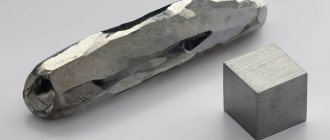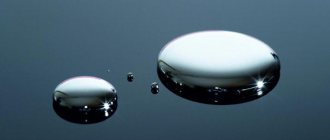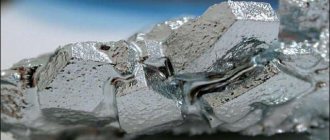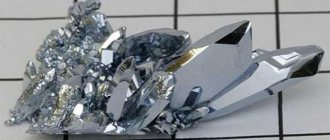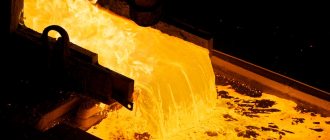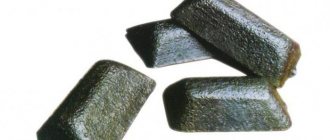Story
The history of iron goes back thousands of years. About 3500 years ago, as A. Azimov wrote,
“iron smelting technology was developed in the Caucasian foothills.”
Ultra-pure iron
The Hittite kingdom was located there. The warlike Hittites guarded the secret of smelting as closely as they could, which is why the price of iron was tens of times higher than the price of gold. Those who wielded iron weapons almost automatically emerged victorious in battles. And the wars were mainly fought over territories.
With the invention of welded weapons came the age of ferrous metal.
In peaceful life, iron tools had enough to do: cut down a hut, hew stone, plow a field.
Organic iron
Removing organic iron is the most difficult. In this case, iron is included in complex organic complexes, which are often quite difficult to oxidize. So to remove it, you have to use other cleaning methods, rather than the classic deferrization using a filter media. Organic iron is often found in water in the form of fine suspensions (colloids). The size of colloids is microns and tens of microns. These contaminants cannot be simply filtered through bed filters, since the size of the colloids is much smaller than the filtration rating, which is approximately 10-20 microns.
Methods for removing organic iron:
- coagulation with filtration on sediment filters;
- coagulation with filtration on ultrafiltration membranes;
- removal of organic compounds on ion exchange resins;
- reverse osmosis.
The main features of organic iron:
- high color;
- high oxidability;
- low pH level;
- approximately the same ratio of divalent and trivalent iron;
- The water has color and no sediment precipitates.
Properties
Iron (Ferrum, denoted Fe in formulas) is a chemically active element and belongs to the metals.
In the periodic table it has atomic number 26. Ferrum is a ferrous metal. Physical characteristics are highly dependent on the purity of the metal.
Important: you need to distinguish harmful impurities from useful ones. Thus, phosphorus and sulfur worsen the characteristics of iron. Carbon improves hardness and mechanical strength.
Iron has 4 modifications; their difference is in structure and crystal lattice.
| Properties of the atom | |
| Name, symbol, number | Iron / Ferrum (Fe), 26 |
| Atomic mass (molar mass) | 55.845(2)[1] a. e.m. (g/mol) |
| Electronic configuration | [Ar] 3d6 4s2 |
| Atomic radius | 126 pm |
| Chemical properties | |
| Covalent radius | 117 pm |
| Ion radius | (+3e) 64 (+2e) 74 pm |
| Electronegativity | 1.83 (Pauling scale) |
| Electrode potential | Fe←Fe3+ −0.04 V Fe←Fe2+ −0.44 V |
| Oxidation states | 6, 3, 2, 0 |
| Ionization energy (first electron) | 759.1 (7.87) kJ/mol (eV) |
| Thermodynamic properties of a simple substance | |
| Density (at normal conditions) | 7.874 g/cm³ |
| Melting temperature | 1812 K (1538.85 °C) |
| Boiling temperature | 3134 K (2861 °C) |
| Ud. heat of fusion | 247.1 kJ/kg 13.8 kJ/mol |
| Ud. heat of vaporization | ~6088 kJ/kg ~340 kJ/mol |
| Molar heat capacity | 25.14[2] J/(K mol) |
| Molar volume | 7.1 cm³/mol |
| Crystal lattice of a simple substance | |
| Lattice structure | cubic body-centered |
| Lattice parameters | 2.866 Å |
| Debye temperature | 460 K |
| Other characteristics | |
| Thermal conductivity | (300 K) 80.4 W/(mK) |
| CAS number | 7439-89-6 |
We recommend: NIOBIUM - myths and reality
Chemical properties of iron:
- Oxidation states +2, +3.
- In the presence of air moisture, it corrodes, and the layer of rust does not prevent further destruction of the metal. Rust does not have a constant formula; its general formula is Fe2O3 x H2O.
- Concentrated solutions of H2SO4 and HNO3 passivate the surface of iron and form an oxide film.
- When interacting with non-metals, they form nitrides, phosphides, silicides, and iron carbides.
- Reacts with metals, reducing them from salt solutions.
- Ferric acid does not exist in free form; its salts - ferrates - have strong oxidizing properties. These properties are used to disinfect water.
What is iron?
From an industrial point of view, iron is the main building material in the world. Its use is everywhere - from door handles to interplanetary rocket engines. The reason for this popularity is simple - the abundance and low cost of raw materials, because iron is in second place in terms of its share in the earth’s crust after aluminum. Symbolic designation of iron "Fe"? and its serial number according to Mendeleev is 26.
Important: do not confuse steel and iron - these are completely different terms. Iron is a pure chemical element, and steel is an alloy of ferum and carbon.
Sometimes iron in the industry is called a highly concentrated alloy with an impurity content of less than 0.7% of the total mass. In this case, the physical properties of the substance are almost not lost. Most iron-based alloys belong to the group of ferrous metals.
| Benefits of Iron | Disadvantages of metal |
| Preservation of elastic properties while increasing the strength of the metal - this is when we are talking about highly concentrated iron alloys. | Weak resistance to corrosion. The problem can be corrected, but production costs increase. |
| The abundance of ferrites makes it possible to produce iron-based materials for any household and industrial purposes. Moreover, a change in properties occurs even with minimal inclusions of impurities. | Due to the accumulation of electricity, iron is susceptible to electrochemical corrosion. For this reason, iron parts must be protected with protectors, cathodes and other protective equipment. |
| Easily machined, which increases variability in the shapes and types of products. | The specific gravity of pure iron makes structures made from it extremely heavy. |
| The magnetic properties of the metal make it possible to produce magnetic drives from it. The high malleability of iron allows it to be made into many decorative elements. |
In its pure form, iron has good ductility, making it easy to forge but difficult to cast. The structure of the metal is 5 phases, each of which has its own crystal structure and lattice parameters. More details in the table below.
| Phase | Peculiarities |
| α | Lattice type – cubic, body-centered shape. Phase stability – up to 770 degrees Celsius. Physical feature – ferromagnetic properties. |
| β | The existence of the phase occurs at temperatures ranging from 770 to 918 degrees Celsius. Complete preservation of physical and chemical properties, except magnetization. Iron becomes paramagnetic. The structure is similar to the previous phase, but the parameters of the lattice are slightly different. |
| γ | The temperature limits of existence are from 918 degrees to 1395 degrees. The key difference is the cubic + face-centric lattice. |
| δ | There is only a lower temperature limit of 1395 degrees. There is no upper limit. The type of lattice structure is volume-centric. |
| ε | The phase does not have clear temperature boundaries, but a necessary condition for its existence is high pressure + the connection of alloying components to pure iron. The lattice type is hexagonal with a dense arrangement of crystals. |
The physical properties of iron directly depend on the purity of the substance. In addition to useful alloying components, which have a positive effect on the properties of the metal, there are also negative elements that can worsen its characteristics. Examples of these could be sulfur and phosphorus, which reduce ductility, in return not providing the alloy with any of the positive properties.
Basic characteristics of iron:
- variable density depending on the residence phase of the metal. The general range is from 7.4 to 7.9 grams/cubic centimeter;
- The resistance of iron in its pure form is low. The tensile strength of ordinary technical iron is 299 MPa, but if we are talking about high-speed steel, then the tensile strength increases to a value of 2.7 GPa;
- pure iron on the Mohs scale is rated at 4 points;
- the conductivity of pure ferum is lower than that of aluminum/copper – 9.7*10^(-8);
- metal can be forged, but in its pure form cannot be cast;
- low toxicity, but not biologically inert.
The absorption of iron by the human body is only ½ of what is received, which makes the metal less dangerous for humans than other elements of the metal group. The main harm to the environment is not caused by iron in its pure form, but by waste during production - gases and slags released. More details about production, thermal characteristics and areas of application will be discussed below.
10 strongest metals in the world
Minerals
There is a lot of iron in the form of compounds and minerals on Earth. It is the second most common metal.
| Iron containing minerals | Name, Fe content (in %%) |
| Hematite (red iron ore) | Up to 70 |
| Magnetite (magnetic iron ore) | 72 |
| Siderite | 35 |
| Marcasite | More than 46 |
| Mispickel | 34 |
| Goethite | 62,9 |
Iron ores are divided into 11 industrial types.
Iron ore
We are proud: Russia has the most iron ores of all countries.
Dissolved iron
Removal of dissolved iron is carried out using catalytic filter media. In this case, iron oxidizes and precipitates on the filter media. the oxidizing agent can either be supplied from outside or located directly in the filter media. The oxidizing agent can be: oxygen, chlorine, potassium permanganate, etc. Often, together with iron, manganese and hydrogen sulfide are found in water. During iron removal, manganese and hydrogen sulfide are also removed.
Main signs of dissolved iron:
- low turbidity;
- low color;
- medium/low oxidation;
- pH level around 7;
- divalent iron is significantly greater than trivalent iron;
- The water is clear, then turbidity appears and sediment appears.
Comparative table of main loads for deferrization:
| Name | Oxidizer | Regeneration | Max: Fe, Mn, H2S | Restrictions |
| BIRM | Oxygen | Backwash | Fe - <5 mg Mn <1 mg/l | pH 6.8-9.0 Hydrogen sulfide Chlorine Salt composition of water |
| GreenSand | On filter media | 3 grams of potassium permanganate per 1 liter of loading | Fe+Mn < 15 mg/l H2S < 5 mg/l | pH 6.2-8.5 |
| DMI | Sodium hypochlorite | Backwash | No restrictions There is experience with Fe=26 mg/l | pH 5.8-8.6 |
BIRM is a lightweight material. Filtration speed 12 m/h. Washing speeds are 20-24 m/h. (the washing speed is 1.8-2.0 times higher than the filtering speed). used when there is a slight excess of iron, in the absence of hydrogen sulfide. If there is manganese in the water, the pH of the water will need to be adjusted. Does not require the addition of reagents. Rinse water can be discharged into any sewer system.
GreenSand (MZ) is a heavier material. Filtration speed 12 m/h. Washing speed 24-29 m/h (washing speed is 2.0-2.2 times higher than the filtration speed). used for high contents of iron, manganese and hydrogen sulfide. Wide range of working pH of water. Requires a regeneration reagent (potassium permanganate). The amount of potassium permanganate per volume of water (Vwater (m3)) is calculated using the formula:
Mmarg(g) = Vwater(m3) x (Fe + Mn x 2 + H2S x 5)(mg/l) x 6
Rinse water cannot be drained into a sewer with biological treatment, since permanganate is a very strong oxidizing agent and its concentration in the rinse water is quite high. Difficulties may arise with the purchase and transportation of potassium permanganate. Potassium permanganate is a rather expensive reagent.
DMI is heavier than GreenSand. Filtration speed 12 m/h. It is possible to increase the filtration speed to 25-20 m/h. Washing speed is 30-40 m/h (washing speed is 2.5-3.3 times higher than the filtering speed). The more accessible and cheaper sodium hypochlorite is used as an oxidizing agent. used for high contents of iron, manganese, hydrogen sulfide. Wider range of water pH. The amount of hypochlorite is calculated for each content of iron, manganese and hydrogen sulfide. Rinse water can be discharged into any sewer system.
Technical Director of Alekseev LLC Denis Vasilyevi
Special offers
Turnkey water treatment system
Our company provides services for the entire range of water treatment: from preparatory design work to commissioning of equipment.
Maintenance and service
We are pleased to offer our clients comprehensive services for water treatment systems. After installing the equipment, we can take over your facility for maintenance.
SOFTNOR reagent-free softening
Unique SOFTNOR technology for reagent-free water softening, developed by specialists from the German company Watch GmbH.
Metal production
There are several ways to get iron:
- Direct methods. This is the production of sponge iron in shaft and tunnel furnaces. Production of iron dough in rotary kilns. It is possible to obtain iron in fluidized bed reactors and the chemical-thermal method.
- The blast furnace process is a common method. Iron ore and flux are reduced by carbon from coke, resulting in cast iron. If necessary, impurities (phosphorus, sulfur) and excess carbon are removed from cast iron in open-hearth furnaces or converters. Alloy steel is produced in electric furnaces (ESF).
- Chemically pure iron can be obtained from a solution of its salts using electrolysis.
Receipt
Until sep. 14th century J. was obtained by the cheese-making method. Iron ore was reduced with charcoal in a forge (cheese-making process); As a result, a kritsa (a block of iron) was obtained, from which the slag was removed and metal was obtained - the raw material for forging decomposition. products. With more intense blasting, the temperature in the forge increased, part of the iron was carburized and turned into cast iron, which, due to its fragility, did not find use and was considered a waste product. From the 14th century Cast iron began to be used for casting castings. products, the forge was reconstructed into a shaft furnace (“domnitsa”), and then into a blast furnace. In the 18th century In Europe, highly refractory crucibles (the crucible process) and the puddling process in a flame reverberatory furnace began to be used for the processing of cast iron into iron (see Pudling). All R. 19th century The Bessemer process, the Thomas process and the open hearth process were developed. steel production; later – electric furnace melting and oxygen-converter processes.
Modern Technologies for obtaining iron from ores include crushing, enrichment of ores to 64–68% iron content, production of concentrate (74–83% $\ce{Fe}$), pyrometallurgical. reduction with coke in a blast furnace (blast furnace process), smelting steel from cast iron in an open-hearth furnace, oxygen converter, electric furnace. Technical Iron (so-called armco iron) is smelted from cast iron in steel furnaces or oxygen converters. Pure iron is obtained by reduction of oxides (at a temperature of 750–1200 °C the so-called spongy iron is obtained), electrolysis of aqueous solutions or molten salts of iron, and decomposition of pentacarbonyl iron $\ce{Fe(CO)5}$ (t N. carbonyl J.). To obtain high-purity iron, zone melting and other methods are used.
Advantages and disadvantages
There are many advantages, but no less disadvantages.
| Advantages | Flaws |
| Easy machining | High density; products turn out heavy |
| Hardness, elasticity, strength - the best properties of alloys | Metal corrosion in the presence of moisture |
| The ability to obtain specified properties of alloys by adding a small amount of impurities | Tendency to electrochemical corrosion |
We recommend: COPPER - the foundation of civilization
Malleability makes it possible to produce decorative products.
Physical properties
Optical
The color is steel-gray to iron-black (ferrite), on a polished surface - white, silver-white to grayish-white (nickel-iron).
- The line is grey-black.
- Metallic shine.
- Transparency Opaque.
Mechanical
- Hardness 4 (iron) - 5 (nickel varieties). Higher hardness often depends on the presence of cohenite. Malleable.
- Density 7.3–7.8 (iron) (calc. 7.87); 7.8-8.2 (nickel-iron).
- Cleavage according to (100) is perfect, separation and slip planes are according to (211). In Ni-containing varieties, cleavage is less clear or absent.
- The fracture is hooked.
Highly magnetic.
Alloys
Markings help to navigate the sea of iron alloys (steels, cast irons). It will help determine the composition of the alloy, the amount of carbon and alloying elements, and distinguish their properties.
A general description can be given by chemical composition: these are carbon and alloy steels.
Steels are divided by application:
| Type and grade of steel | Application |
| Construction St0-3 | Secondary structural elements made with little responsibility (railings, decking) |
| Construction St3 | Can be used for load-bearing structures, but at positive temperatures |
| Structural St20 | Lightly loaded parts |
| Alloyed 10HSND | Used in welded structures of ship and carriage building, chemical engineering |
| Alloyed 18ХГТ | Withstands shock loads, high pressure |
| Alloyed 09G2S | For work under pressure, at temperatures from -70 to +450 degrees. |
Physical properties
The properties are close to those of telluric iron. Kamacite is gray in color. Magnetic Tanite is white. When the Ni content is above 26-30%, it loses its magnetic properties. Hardness increases as Ni content increases.
Chemical properties
The composition of meteorite iron is always nickel; also contains Co, Cu, C, P, S, and from gases - H.
Kamacite does not melt under a blowpipe; taenite in thin fragments melts and darkens; Like terrestrial nickel-iron, taenite is less susceptible to acid attack than kamacite.
Finding
Kamacite forms the basis of the iron part of iron meteorites, composes almost entirely meteorites of the hexahedrite group, and is the main mineral of meteorites of the octahedrite group and the iron part of stony meteorites. Taenite is found in meteorites in minor quantities; Only in very rare Ni-rich meteorites does its content reach 70%. Occurs mainly in coarse-grained octahedrites. In fine-grained octahedrites its content decreases. Meteoric iron is also observed in atmospheric dust (silt particles) falling along with hail and snow.
Diagnostic signs
In most cases, it differs from telluric iron in clearly defined Widmanstätten figures, revealed on polished surfaces by HNO3 etching. In telluric iron these figures are weakly expressed or absent.
Application
More than 90% of all metallurgical production is occupied by iron and its alloys.
Products made from steels and cast irons are an irreplaceable and major part of structural materials, including buildings, bridges, railways and much more.
Application of iron compounds:
- Divalent and trivalent iron is used as a coagulant in water treatment systems;
- the anodes in iron-nickel and iron-air batteries are made of the most famous ferrous metal;
- magnetite in the form of ultrafine powder is used in black and white laser printers;
- FeCl3 is used by radio amateurs (etching printed circuit boards);
- Magnetite is indispensable in the manufacture of memory media (hard drives).
Areas of application of iron
For most organisms, there is no life without iron; with its help, oxygen is delivered to every cell of the body. Lack of iron leads to chlorosis in plants and iron deficiency anemia in animals.
Cognitive: the belief that an apple when cut is darkened by the iron contained in it is a myth.
Areas of application of iron and its alloys
So, let's find out why iron is most used in metallurgy.
Iron often means not a substance as such, but low-carbon electrical steel - this is the name of the metal alloy according to GOST. Truly pure iron is not easy to obtain, and it is used exclusively for the production of magnetic materials.
Iron is ferromagnetic, meaning it becomes magnetized in the presence of a magnetic field. However, this property is highly dependent on the impurities and structure of the metal. The magnetic properties of absolute pure iron are 100–200 times higher than those of commercial steel. The same can be said about the grain size: the larger the grain, the better the magnetic properties of the substance. Mechanical processing also matters, although its influence is not so impressive. Only such iron is used to produce all magnetic materials for electrical engineering and magnetic drives.
In all other areas of the national economy, steel and cast iron are used, so when speaking about the use of iron, they talk about the use of steel.
The video below will tell you about the methods of using iron alloys:
Connections
All metals used in production are divided into non-ferrous and ferrous. Ferrous are iron alloys, in particular steel and cast iron, the rest are copper, nickel, silver and are non-ferrous. Accordingly, the production involved in the smelting of cast iron and steel is called ferrous metallurgy, and all others are called non-ferrous metallurgy. Ferrous metallurgy accounts for 95% of all metallurgical processes. Ferrous alloys are divided in this way:
- steel is an alloy of iron with carbon and other ingredients, whose mass fraction does not exceed 2.14%. Carbon gives steel its ductility and hardness. The composition may also include manganese, phosphorus, sulfur, and so on;
- cast iron is an alloy with carbon, where a higher content of the element is allowed - up to 4.3%. Moreover, cast irons differ in their properties depending on the form in which the alloy contains carbon: if the substance reacted with iron, white cast iron is obtained, if included in the form of graphite, gray cast iron is obtained;
- ferrite - iron with a minimal admixture of carbon and other elements - 0.04%. Actually, this is chemically pure iron;
- pearlite is not an alloy, but a mechanical mixture of iron carbide and ferrite. Its properties differ markedly from those of metal;
- Austenite is a solution of carbon in iron with a proportion of the former up to 0.8%. Austenite is characterized by plasticity and does not have magnetic properties.
Read below about methods of using iron in the form of steel.
Become
Of course, steel and cast iron are most widely used, and their use depends on the proportion of carbon in the composition. On this basis, carbon and alloy steels are distinguished. In the first case, the impurities are permanent, that is, they enter the alloy due to the peculiarities of the smelting process. Alloyed additives are added specifically to give the material special properties. Vanadium, titanium, chromium, nickel, and so on are used as alloying elements.
Carbon steels are divided into 3 groups:
- low-carbon - the proportion of the element is less than 0.25%, the most malleable and ductile;
- medium-carbon – with a carbon share of up to 0.6%;
- high-carbon – element content exceeds 0.6%.
Alloy steels also comprise 3 groups:
- low-alloy – the mass fraction of all components is 2.5%:
- medium alloyed – here the total content can reach 10%;
- highly alloyed - the proportion of alloying elements exceeds 10%.
Alloy steels are usually used as a material for tools and machine components, since the addition of additional ingredients increases the strength of the alloy, gives it heat resistance or corrosion resistance. Carbon steels are mainly used for frame structures, making water pipes, and so on.
All steel can be divided according to purpose:
- construction - these are mainly high- or medium-carbon steels. Alloys are used for all construction work: from the construction of metal frames to the manufacture of household items and roofing sheets;
- structural - low-carbon steels with an element fraction of up to 0.75%. This is a material for all branches of mechanical engineering - from bicycles to marine vessels;
- instrumental - low carbon, but differs from structural also in its very low manganese content - no more than 0.4%. This is the basis of measuring, stamping, cutting tools;
- special steels - are divided into 2 subtypes: with special physical qualities - electrical steel with specified magnetic properties, and with special chemical properties - heat-resistant, stainless steel, and so on.
The use of alloy steels is determined by their qualities.
- Thus, stainless steel is used in construction and mechanical engineering, where higher than usual corrosion resistance is required.
- Heat-resistant alloys “work” in conditions of high temperatures – turbines, heating lines. Heat-resistant - do not oxidize at high temperatures, which is important for many working units in heating engineering.
Another division of alloys is by quality. This parameter determines the content of phosphorus and sulfur - harmful impurities that reduce the strength of the alloy. There are 4 types:
- ordinary quality steel includes up to 0.06% sulfur and 0.07% phosphorus. These are common building materials used in the manufacture of pipes, channels, angles, profiles and other rolled metal;
- high-quality - allows a sulfur content of up to 0.035% and the same proportion of phosphorus. Also used in the production of rolled metal, housings, machine parts and some grades of tool steel;
- high quality - the proportion of sulfur and phosphorus does not exceed 0.025%, respectively. This category includes tool and structural steels used under high load conditions;
- especially high quality – sulfur content less than 0.015%, phosphorus content less than 0.025%. This material is characterized by maximum wear resistance. Some grades are allocated to a special category and are marked accordingly, for example, ball-bearing steel, or high-speed steel - an indispensable element of a high-quality cutting tool.
The video below will tell you about the use of cast iron and steel:
Cast iron
The use of cast iron is not much less, since its mechanical qualities are quite comparable to many grades of steel. Depending on the category of cast iron, the application also differs:
- gray cast iron - carbon in iron is in the form of graphite plates. It has good casting properties and low shrinkage. But its most remarkable quality is its resistance to variable loads. Gray cast iron is used in the manufacture of rolling machines, beds, bearings, flywheels, piston rings, parts of tractor and automobile engines, housings, and so on;
- white cast iron - carbon bonded to iron. Almost entirely used to produce steel;
- high-strength cast iron - carbon is in the form of spherical inclusions. This shape provides high resistance to tensile and bending loads. Turbine parts, crankshafts of tractors and cars, gears, molds, and so on are made from cast iron.
Cast iron can also be alloyed to create an alloy with a wide variety of properties.
- Wear-resistant cast iron is used for the manufacture of pump parts, brakes, and clutch discs.
- Heat-resistant is used in the construction of blast furnaces, open-hearth furnaces, thermal furnaces.
- Heat-resistant is used in the construction of gas furnaces, in the manufacture of compressor equipment, and diesel engines.
Next, the practical application of iron is considered based on its physical properties in the construction industry.
The beginning of the history of iron
In the third millennium BC. e. people began to mine and learned to process bronze and copper. They were not widely used due to their high cost. The search for new metal continued. The history of iron began in the first century BC. e. In nature, it can only be found in the form of compounds with oxygen. To obtain pure metal, it is necessary to separate the last element. It took a long time to melt the iron, since it had to be heated to 1539 degrees. And only with the advent of cheese-making furnaces in the first millennium BC did they begin to obtain this metal. At first it was fragile and contained a lot of waste.
With the advent of forges, the quality of iron improved significantly. It was further processed in a blacksmith, where the slag was separated by hammer blows. Forging has become one of the main types of metal processing, and blacksmithing has become an indispensable branch of production. Iron in its pure form is a very soft metal. It is mainly used in an alloy with carbon. This additive enhances the physical property of iron, such as hardness. The cheap material soon penetrated widely into all spheres of human activity and revolutionized the development of society. After all, even in ancient times, iron products were covered with a thick layer of gold. It had a high price compared to the noble metal.
Feature properties
One of the physical properties of iron is ferromagneticity. In practice, the magnetic properties of this material are often encountered. This is the only metal that has such a rare feature.
Under the influence of a magnetic field, iron is magnetized. The metal retains its formed magnetic properties for a long time and remains a magnet itself. This exceptional phenomenon is explained by the fact that the structure of iron contains a large number of free electrons that can move.

